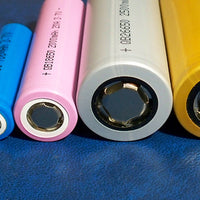Lithium iron phosphate battery is a lithium-ion battery using lithium iron phosphate as the cathode material and carbon as the negative electrode material. The lithium iron phosphate battery assembly production process is divided into three major sections, the production of electrodes, the second is the production of cells, and the third is battery assembly.
In the lithium iron phosphate battery assembly production process, the production of the electrode is the basis, the core of the cell production, battery assembly is related to the quality of the finished lithium battery.
A, lithium iron phosphate battery assembly method
1, Choose the right cell, the cell type, voltage, and internal resistance need to match, please do a good balance of the cell before assembly. Cut electrodes and punch holes.
2, Calculate the distance according to the hole and cut the insulation board.
3, on a good screw, please use the flange nut to prevent the nut off, on a good screw connection, you can fix the lithium iron phosphate battery pack.
4, connect and solder line, connect the voltage acquisition line (equalization line), and do not external protection board, to avoid accidental burnout of the protection board.
5, insulating silicone again fixed, this silicone will cure over time.
6, place the protection plate, if you forget to do the equalization of the core before, this is the last chance before the assembly of lithium batteries, you can do equalization through the equalization line.
7, then use the insulation plate to fix the entire lithium iron phosphate battery pack, with a nylon tape package, nylon tape is more resistant, please note that we have not been using steel shell, steel shell is certainly beautiful and strong, but the core bonding is difficult to guarantee that some shells are not handled well is likely to scratch the core causing leakage, and even accidents caused by poor insulation.
8, and then the overall package core, please be sure to fix the core and protection plate, our core measured 1-meter height fall still ensures normal operation.
9, the final package is complete, and the output input is used silicone wire. Overall because of the lithium iron cells, 48V20AH lithium battery pack, battery pack single weight of 9 kg, the weight is half of the equivalent acid body battery.
10, the tutorial is complete, after the completion of the lithium iron phosphate battery pack we did a test, that can meet our requirements.
B, the process steps of lithium iron phosphate battery assembly technology
1. Battery material treatment: Some materials used for secondary batteries, such as lithium-ion, require special treatment. The electrodes should be handled at high speed without damaging the fragile active material. In the electrolyte, special consideration is needed to prevent the generation of precipitation and corrosive gases.
2. Cam unit: If a machine is constructed with a cylinder or AC servo actuator to have a beat time of less than 1 second, it is difficult to synchronize or maintain a stable state for a long time even if it is kept in good condition when a new machine is installed. Then, the cylinder reaches the end of its running distance in a short period, so its maintenance cycle is short. In the cam mechanism of machine construction, it can solve such a problem because all the drives are kept by the smallest motor.
3. Mounting and base: Establishing a strong mounting and base for the machinery is important to maintain stability over time. Mounting and bases can reduce start-up time by minimizing deviations in the accuracy of the transfer and transmission mechanisms. Typically, the use of aluminum frames is eliminated. Stable bases are constructed using thick square logs and substantial foundations from the tank manufacturing process. For various requirements, annealing is possible and mountings with additional precision are used.
4. Vacuum processing: Not only a simple vacuum chamber and furnace but also a mechanism for vacuum chamber operation process and liquid application equipment. Need to have extensive knowledge of special vacuum equipment and parts such as vacuum pumps, pipes, and valves.
5. Precise positioning: It is necessary to have the positioning technology and experience to be able to handle the calibration system efficiently according to the needs such as mechanical positioning and image processing. To maintain accuracy for a long time, to achieve control of the camera or positioning table, but also to achieve precise positioning, including the installation design.
6. Laser welding: If possible, according to individual needs, such as CO2, YAG, LED, fiber, and other knowledge and results of various lasers, for example, laser welding of thin foil of lithium iron phosphate batteries, throttle shell, and cover welding, resin welding instead of metal, etc. The specifications and selection of welding machines suggest the most suitable welding method.
7. Pressing: Technology and experience are required to cope with various presses, such as air, hydraulic, and servo. We have a wide range of results, from testing production levels of robotic arm presses to machine platforms with servo motors to producing products with high precision and high-quality control speed and torque.
8. Dimensional measurement: Dimensional measurement using laser displacement gauges, image processing equipment, contact, and non-contact sensors, etc. for various methods. In production machines, correct dimensions cannot be measured using only measuring equipment. Therefore, it is important to maintain accuracy in all aspects, including mounting vibration, etc.
Before assembling the lithium iron phosphate(LiFePO4) battery pack, you need to calculate the size of the product and the required load capacity of the lithium battery pack, and then calculate the capacity of the lithium battery pack to be assembled according to the required capacity of the product, and then select the lithium battery according to the calculation results.







0 comments